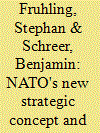| Srl | Item |
| 1 |
ID:
093085


|
|
|
|
|
| Publication |
2009.
|
| Summary/Abstract |
The rise of China poses a great challenge for the transatlantic alliance. Although the common values that bind Europe and North America will not vanish, increasing demands on US resources from the Asia-Pacific region will erode the pre-eminence of the Atlantic alliance in American security policy. NATO must therefore adapt to the new reality by acknowledging the global nature of US commitments in its new Strategic Concept - and European powers must have a debate about the implications of East Asia for their own security.
|
|
|
|
|
|
|
|
|
|
|
|
|
|
|
|
| 2 |
ID:
118898


|
|
|
|
|
| Publication |
2012.
|
| Summary/Abstract |
Everyday technologies of the nineteenth century-mass-produced items that were small, sturdy, and affordable-transformed the daily lives of working people in Asian colonies. There is already a large literature on colonial technology transfer and a specialist literature on the sewing-machine, which draws on Singer archives, production figures, sales techniques, and advertising to establish uptake by households from North America to the Philippines, India, China, and Egypt. Still, documentation of how and why imported objects such as the sewing-machine were appropriated is difficult to find because, unlike elites, ordinary people left few records of their own. Here a visual archive is investigated to complement existing studies. Photographs and early moving pictures from the former Dutch East Indies show that ordinary Indonesians sought and appropriated imported goods such as the sewing-machine. The colonial camera's visual record of sewing-machine operators displaces attention from the more impersonal trade and productivity statistics. It brings the silent user into the history of technological uptake and allows us to consider the repercussions across a wide social band and period. Indigenous tailors and seamstresses expanded their own work options. Through the Singer they fitted out and launched their compatriots into modern jobs and lifestyles in the Dutch colony. The sewing-machine changed habits, manners, and expectations; machine operators influenced senses of propriety, fashion, and status. Appropriation of mundane technology demonstrates that modernization was not only a process trickling down to the masses from Westernizing elites; it also bubbled up from below.
|
|
|
|
|
|
|
|
|
|
|
|
|
|
|
|
| 3 |
ID:
085999


|
|
|
|
|
| Publication |
2008.
|
| Summary/Abstract |
Illegal migration- also known as clandestine, undocumented or irregular migration-appears frequently in contemporary popular and political discourses; yet there is relatively little theoretical literature on the phenomenon. Nearly all academic and other discussions of the topic take as axiomatic that illegal migration is a 'problem', without pausing to question its rapid rise to prominence and the underlying issues that may be involved. It is the aim of this paper to search a little deeper into the historical and structural factors germane to the phenomenon: little attention will be paid to detailed empirical matters, since such information is available elsewhere. I start with some definitional issues then, taking an overview of the history of migration controls, I proceed to a discussion of the complex structural factors that have contributed to the emergence of illegal migration as a putative 'crisis' in the developed world.
|
|
|
|
|
|
|
|
|
|
|
|
|
|
|
|